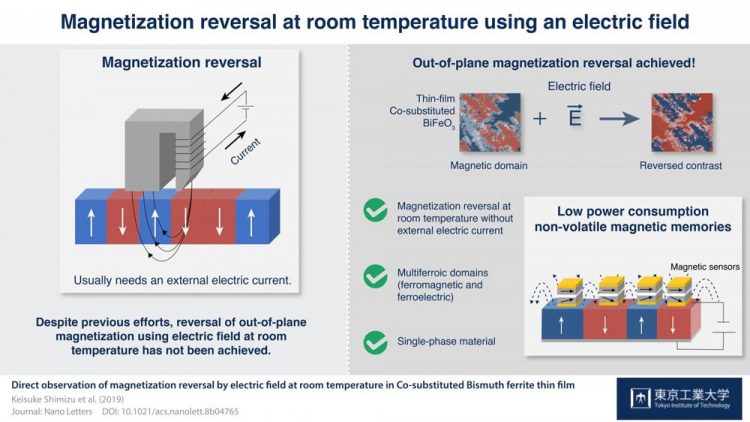Magnetization reversal achieved at room temperature using only an electric field

Magnetization reversal at room temperature using an electric field. Credit: Keisuke Shimizu, Masaki Azuma, Tokyo Institute of Technology
In the era of information technology revolution, electronics demand rapid evolution facilitated by greater efforts from materials researchers to pave the way for further improvements and novel devices.
In particular, a better understanding of the electromagnetic properties of various types of materials and new ways to harness them would allow for the fabrication of devices based on such principles.
Two years ago, a research team from the Laboratory for Materials and Structures at Tokyo Institute of Technology (Tokyo Tech), led by Prof. Masaki Azuma, demonstrated very promising properties of Cobalt-substituted Bismuth ferrite (BFCO).
This peculiar material exhibits both ferroelectric and ferromagnetic properties at room temperature; these two are coupled in a way that, the team inferred, could be exploited to exhibit reversal of the magnetization of the material by application of only an electric field at room temperature without the need of electric current.
In a more recent study, the team presented proof of this hypothesized magnetization reversal in thin films of BFCO at room temperature. While previous researchers saw some success in achieving magnetization reversal, their results were for in-plane magnetization on a multi-layer material, which carries some disadvantages.
“Direct observation of magnetization reversal on a single-phase material with ferroelectric and ferromagnetic orderings is crucial to the study of the intrinsic coupling between them. Moreover, out-of-plane magnetization reversal is desirable from the viewpoint of integration,” explains Azuma.
Thus, the team fabricated thin BFCO films that exhibited spontaneous magnetization. Because BFCO is very sensitive to lattice strain, these thin films were grown on orthorhombic GdScO3, whose lattice structure matches that of BFCO maximally and bolster the growth of highly crystalline films with minimal lattice strain.
After verifying the presence of the sought-after out-of-plane magnetization, the team went on to investigate the correlation between the ferromagnetic and ferroelectric domains to see if magnetization reversal was possible by switching electric polarization.
In the resulting piezoelectric force microscopy and magnetic force microscopy images, the researchers found that their attempts were successful and that it was indeed possible to achieve out-of-plane magnetization reversal using an electric field at room temperature.
This represents the first time that such a feat was carried out, and could soon become the operating principle of a new type of memory device, as explains Azuma: “The current demonstration of magnetic reversal using an electric field paves the way to low power-consumption, non-volatile magnetic memories, such as magnetoresistive random-access memories.”
These findings also bring hope to all researchers in this particular field who, although had collectively been working on magnetization reversal for 15 years, had not yet reported such promising results.
Media Contact
More Information:
http://dx.doi.org/10.1021/acs.nanolett.8b04765All latest news from the category: Power and Electrical Engineering
This topic covers issues related to energy generation, conversion, transportation and consumption and how the industry is addressing the challenge of energy efficiency in general.
innovations-report provides in-depth and informative reports and articles on subjects ranging from wind energy, fuel cell technology, solar energy, geothermal energy, petroleum, gas, nuclear engineering, alternative energy and energy efficiency to fusion, hydrogen and superconductor technologies.
Newest articles

First-of-its-kind study uses remote sensing to monitor plastic debris in rivers and lakes
Remote sensing creates a cost-effective solution to monitoring plastic pollution. A first-of-its-kind study from researchers at the University of Minnesota Twin Cities shows how remote sensing can help monitor and…

Laser-based artificial neuron mimics nerve cell functions at lightning speed
With a processing speed a billion times faster than nature, chip-based laser neuron could help advance AI tasks such as pattern recognition and sequence prediction. Researchers have developed a laser-based…

Optimising the processing of plastic waste
Just one look in the yellow bin reveals a colourful jumble of different types of plastic. However, the purer and more uniform plastic waste is, the easier it is to…



